
Quantum Efficiency Tester
PL/EL Integrated System
PV-Reflectumeter
3D Confocal Microscope
In-Line Four Point Probe Tester
Four Point Probe Tester
In-Line Thin Film Thickness Tester
Raman Spectrometer
FTIR Spectrometer
Spectrophotometer
Automatic Spectroscopic Ellipsometer
Contact Resistance Tester
Ultra depth of field 3D microscope
Auto Visual Tester
VMM PV Vision Measuring Machine
Solar Cell Horizontal Tensile Tester
Steady State Solar Simulator for Solar Cell
Solar Cell UV Aging Test Chamber
Solar Cell Comprehensive Tensile Tester
Visual Inspection Tester
Wet Leakage Current Tester
PV Module EL Tester
PV Module UV Preconditioning Chamber
Steady State Solar Simulator for PV Module
Current Continuous Monitor
Potential Induced Degradation Test
Bypass Diode Tester
LeTID Test System
Reverse Current Overload Tester
Impulse Voltage Tester
Hipot Insulation Tester
Ground Continuity Tester
Hipot Insulation Ground Tester
Damp Heat Test Chamber
Humidity Freeze Test
Thermal Cycle Test Chamber
Dynamic Mechanical Load Tester
Static Mechanical Load Tester
Hail Impact Tester
Robustness of Termination Tester
Module Breakage Tester
Cut Susceptibility Tester
Peel Shear Strength Tester
Universal Testing Machine (Single-arm)
Universal Testing Machine (Double-arm)
Glass Transmittance Tester
Acetic Acid Test Chamber
EVA Degree of Crosslinking Test System
Junction Box Comprehensive Tester
Drop ball tester
Semi-automatic scanning four-probe tester
Stylus Profilometer
Maximum Power Point Tracker
Perovskite Glass Transmittance Tester
Perovskite P1 Laser Scribing Multifunctional Testing Machine
Perovskite Online PL Tester
Perovskite Online Sheet Resistance Tester
Online Perovskite Film Thickness Tester
Perovskite Process Inspection Workstation
Portable IV Curve Tester
Portable EL Tester
Portable Thermal Imaging Tester
Solar Module Multi-Channel Testing System
PV Inverter Power Quality Tester
Drone EL Tester
IV Tester
IVEL Cell Sorting Machine
Impact of UV-induced Degradation (UVID) on TOPCon Modules
Date : 2024-09-30Views : 445
TOPCon photovoltaic modules have been rapidly promoted and applied worldwide as the technology matures and costs decrease. However, due to the increased sensitivity of cells to ultraviolet radiation, TOPCon technology is susceptible to UV-induced degradation (UVID), which affects the performance, life and warranty of the modules. Millennial Solar Cell UV Preconditioning Chamber can monitor the changes of modules under light by simulating different light conditions. It can be used for photovoltaic module product development and quality control or to evaluate the change test of module durability after assembly.
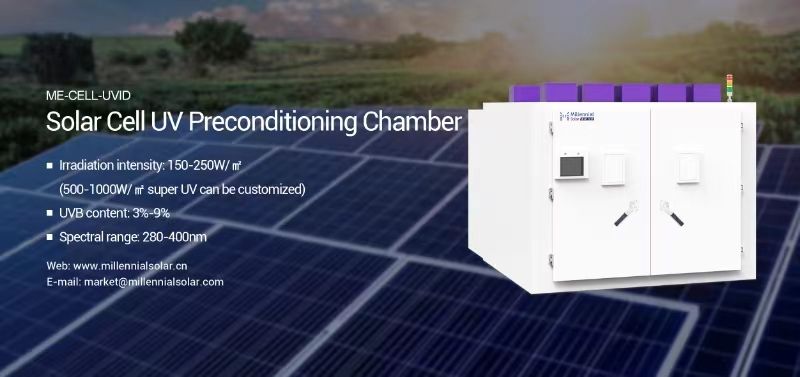
UVID-induced degradation mode
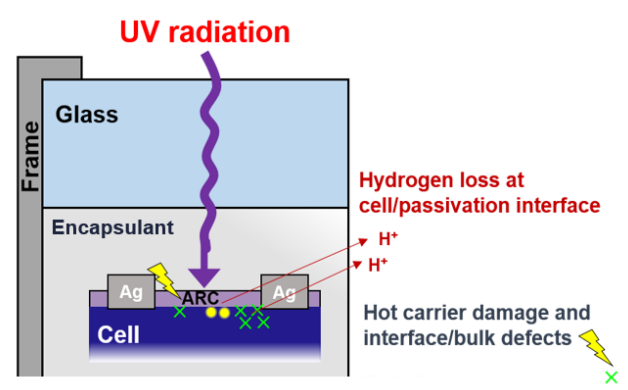
UVID-induced degradation mode
Recombination of SiNx/Si interface: When UV photon energy is greater than 3.5eV (λ<360nm), the Si-H bond at the SiNx/Si interface is broken. By generating dangling bonds, the passivation quality is reduced, thereby increasing the emitter saturation current and reducing the carrier lifetime.
Silicon body recombination: UV causes carrier injection, changes the impurity charge state (and mobility), and combines to form bulk defect centers during the transfer process. The formation of such bulk defect centers further affects the performance and stability of the cell.
Hot carrier effect: Hot electrons (with high mobility and high kinetic energy) are generated. When hot electrons exceed the interface barrier, they damage the passivation layer and increase the interface state density. This effect also damages key structures such as the passivation layer of the cell, thereby affecting the overall performance.
UVID test process and conditions
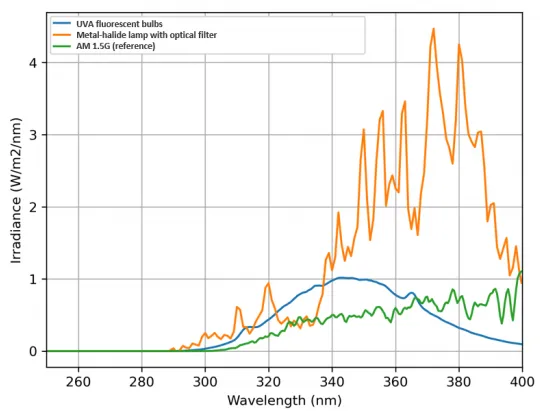
The modules were exposed to 120kWh/m² of UV (280 - 400nm) on the front side at 60°C short circuit conditions. The total UV dose is equivalent to 1-2 years of outdoor exposure (depending on the location). The UVID test setup complies with IEC61215:2021 MQT10 requirements, using metal halide lamps with UVB content in the range of 3-9%.
Power degradation analysis
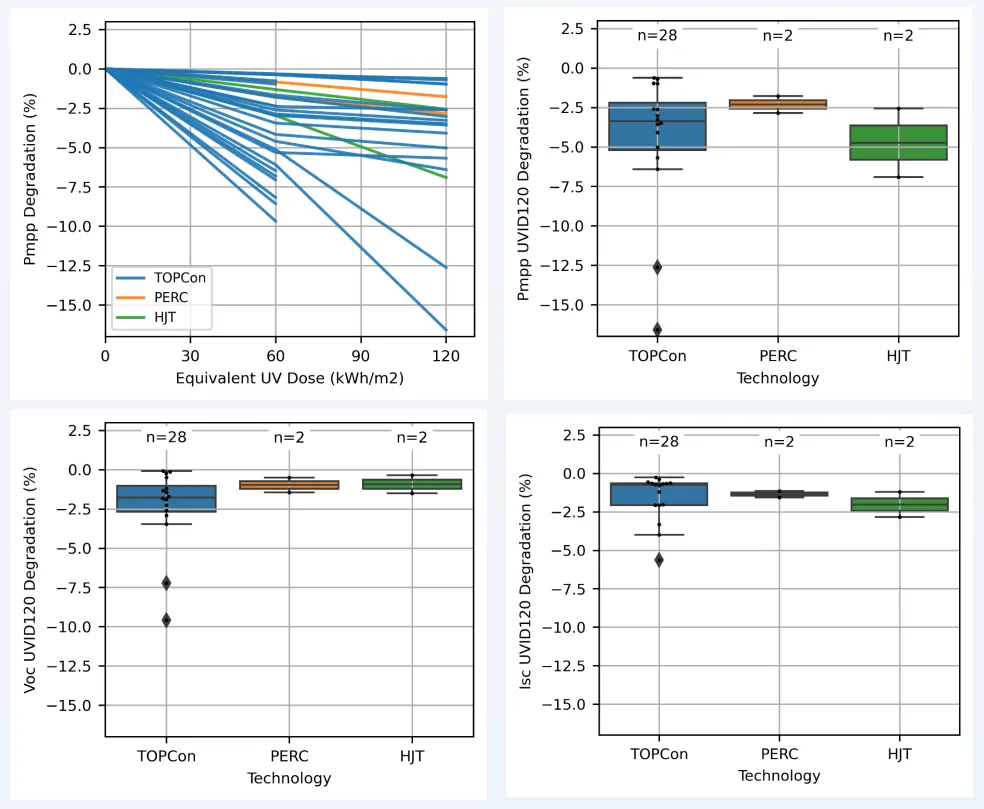
Overall power loss range:
The power loss after UVID-120 ranges from 0.6% to 16.6%. This data shows that the power loss of different modules after UVID testing varies greatly, reflecting the differences in the sensitivity of modules to UVID and the different resistance to degradation of different modules.
Power degradation of TOPCon modules:
More than 50% of TOPCon modules show power degradation > 5%/year, which indicates that the power degradation of TOPCon modules under the influence of UVID is more obvious, which is a problem that needs to be focused on and studied.
Analysis of affected parameters:
Voc is the most affected parameter, which is attributed to passivation loss; followed by Isc and FF. In modules with good performance, Isc has the smallest loss.
This difference in the affected parameters provides important clues and directions for in-depth research on UVID degradation mechanisms and improving module performance.
Measures and progress in dealing with UVID
UV rays can affect the TOPCon cell passivation layer, and PV manufacturers are actively seeking treatment methods to mitigate this effect. By following the IEC61215:2021 MQT10 UV detection standards and procedures, some manufacturers seem to have controlled UVID to a certain extent.
One of the best ways to ensure that TOPCon modules are resistant to UVID is through UV testing, which helps to screen out modules with excellent performance and improve product reliability and stability to meet the market demand for high-quality photovoltaic modules.
Solar Cell UV Preconditioning Chamber
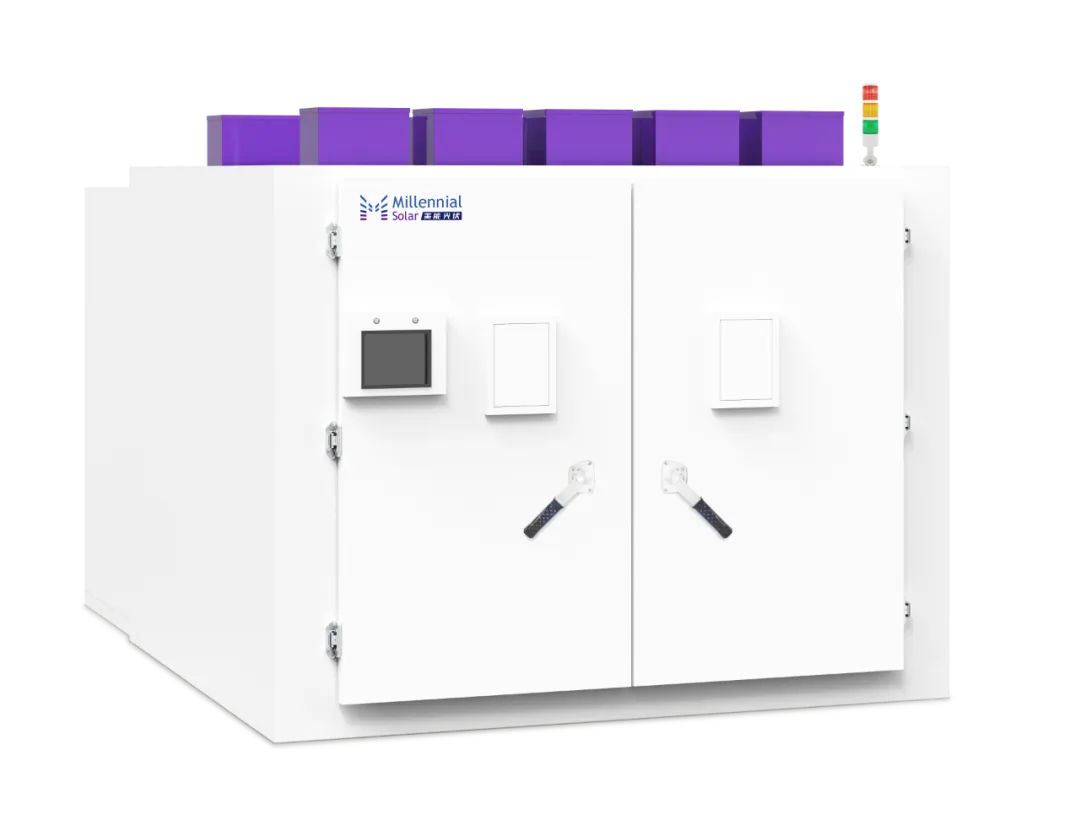
E-mail: market@millennialsolar.com
Solar Cell UV Preconditioning Chamber monitors the changes of components under light by simulating different light conditions. It can be used for photovoltaic component product development and quality control or to evaluate the change test of modules durability after assembly.
· Irradiation intensity: 150-250W/㎡ (500-1000W/㎡ super UV can be customized)
· UVB content: 3%-9%
· Spectral range: 280-400nm
Through ultraviolet (UV) aging testing, the entire photovoltaic industry has been provided with useful experience and reference in dealing with UVID issues, which has promoted the industry to continuously improve technology and product quality. Solar Cell UV Preconditioning Chamber can evaluate the stability of the module after long-term environmental exposure in detail, and can also provide key data for product development and quality control.

































































